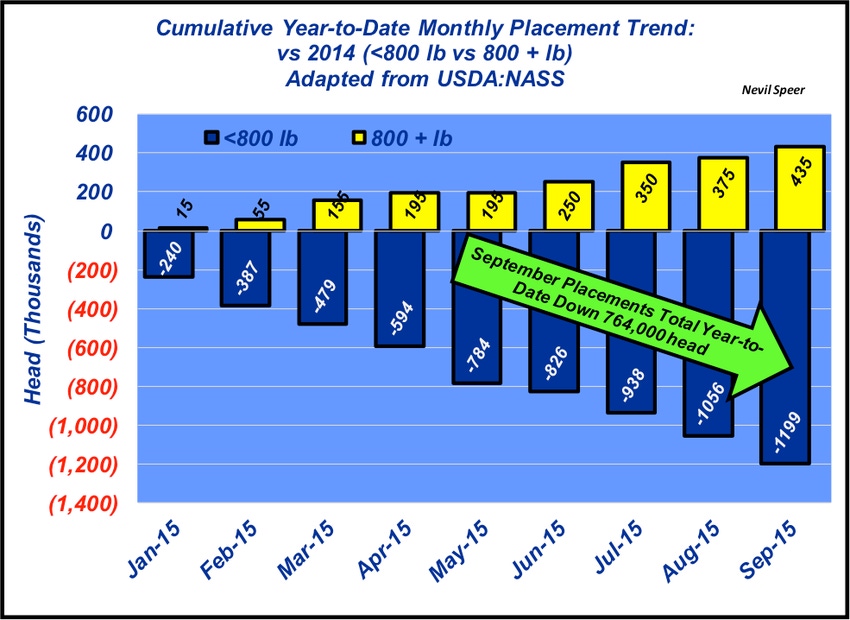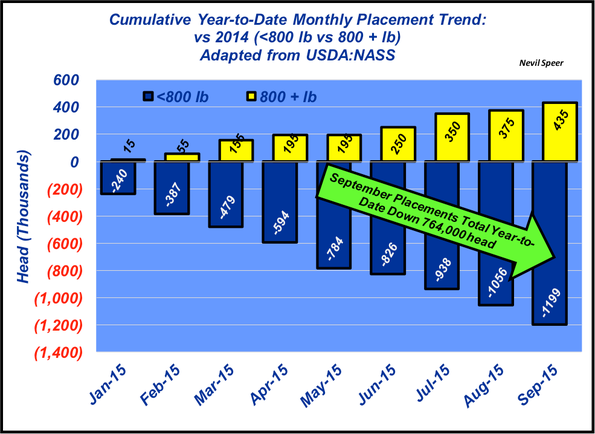Heavy in – heavy out: Feedyard placement weights record high
Feedyard placements in the lightest weight categories are running behind last year.
November 12, 2015

Feedyard placement dynamics have proven to be very important throughout the year. That’s been especially true of late. Market pressure since April has made fed cattle sellers reluctant participants, with the result being slower marketings. Subsequently, placements on the other side also slow down. Through September, total feedyard arrivals are down 764,000 versus 2014.
However, there’s an important story within that story. That is, the placement decline is completely comprised by the three lightest categories—less than 600 pounds; 600-699 pounds; and 700-799 pounds, respectively. In fact, total placements in those three categories are down nearly 1.2 million head compared with 2014 placements.
 Meanwhile, delivery of feeders weighing more than 800 pounds is up 435,000 year-to-date. To that end, September placements were the heaviest on record – that’s the direct result of cattle weighing over 800 pounds comprising nearly 43% of all arrivals, also a new record. Placements of heavier cattle over time isn’t a new phenomenon. However, from a broader perspective, the trend of late is a significant uptick from that longer-running trend.
Meanwhile, delivery of feeders weighing more than 800 pounds is up 435,000 year-to-date. To that end, September placements were the heaviest on record – that’s the direct result of cattle weighing over 800 pounds comprising nearly 43% of all arrivals, also a new record. Placements of heavier cattle over time isn’t a new phenomenon. However, from a broader perspective, the trend of late is a significant uptick from that longer-running trend.
Slaughter weights and carcass weights have established new records in recent weeks. The placement trend in 2015 is an important contributor to heavier slaughter weights that are being witnessed in the beef complex: heavy in – heavy out. Simultaneously, heavier weights are also indicative of lack of currentness—and historically, that often becomes a self-perpetuating phenomenon.
Where do you see these trends headed? Will feedyards continue to emphasize heavy cattle in the coming months? Given current market expectations among producers, the trend in the country seems to favor calves staying at home and more weight being added in lieu of selling now; will sellers continue to accommodate the desire for heavier cattle? What, if anything, will change the direction of these trends?
Leave your thoughts in the comments section below.
Nevil Speer is based in Bowling Green, Ky., and serves as vice president of U.S. operations for AgriClear, Inc. – a wholly-owned subsidiary of TMX Group Limited. The views and opinions of the author expressed herein do not necessarily state or reflect those of the TMX Group Limited and Natural Gas Exchange Inc.
You might also like:
Is ranching an art or a science or both?
Crunch the numbers before you buy those heifers
8 apps for ranchers recommended by ranchers
Act now to minimize cold stress on cattle this winter
10 lessons I want to share with my teenage son
Why you must remove net wrap on round bales before feeding to cattle
About the Author(s)
You May Also Like




.png?width=300&auto=webp&quality=80&disable=upscale)
